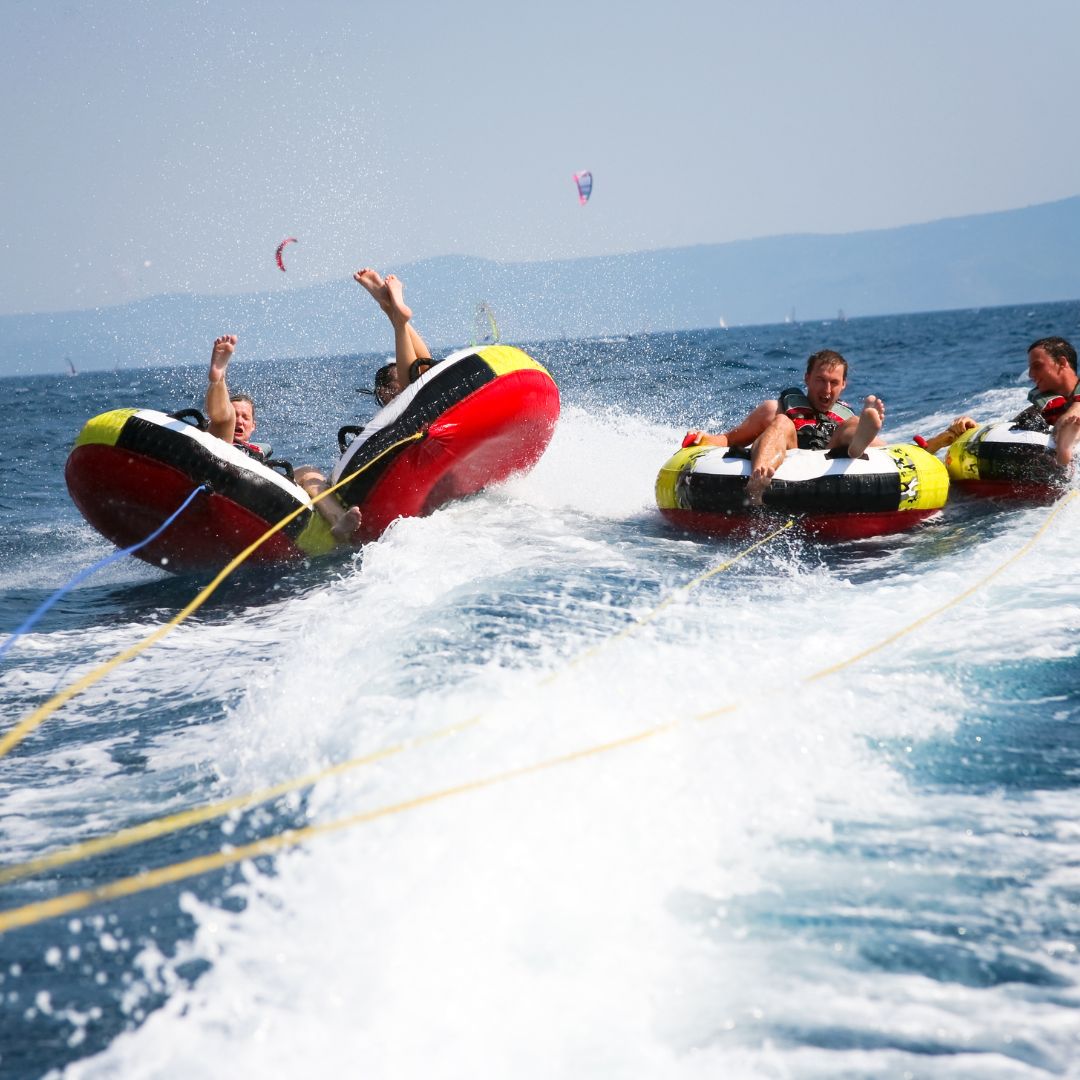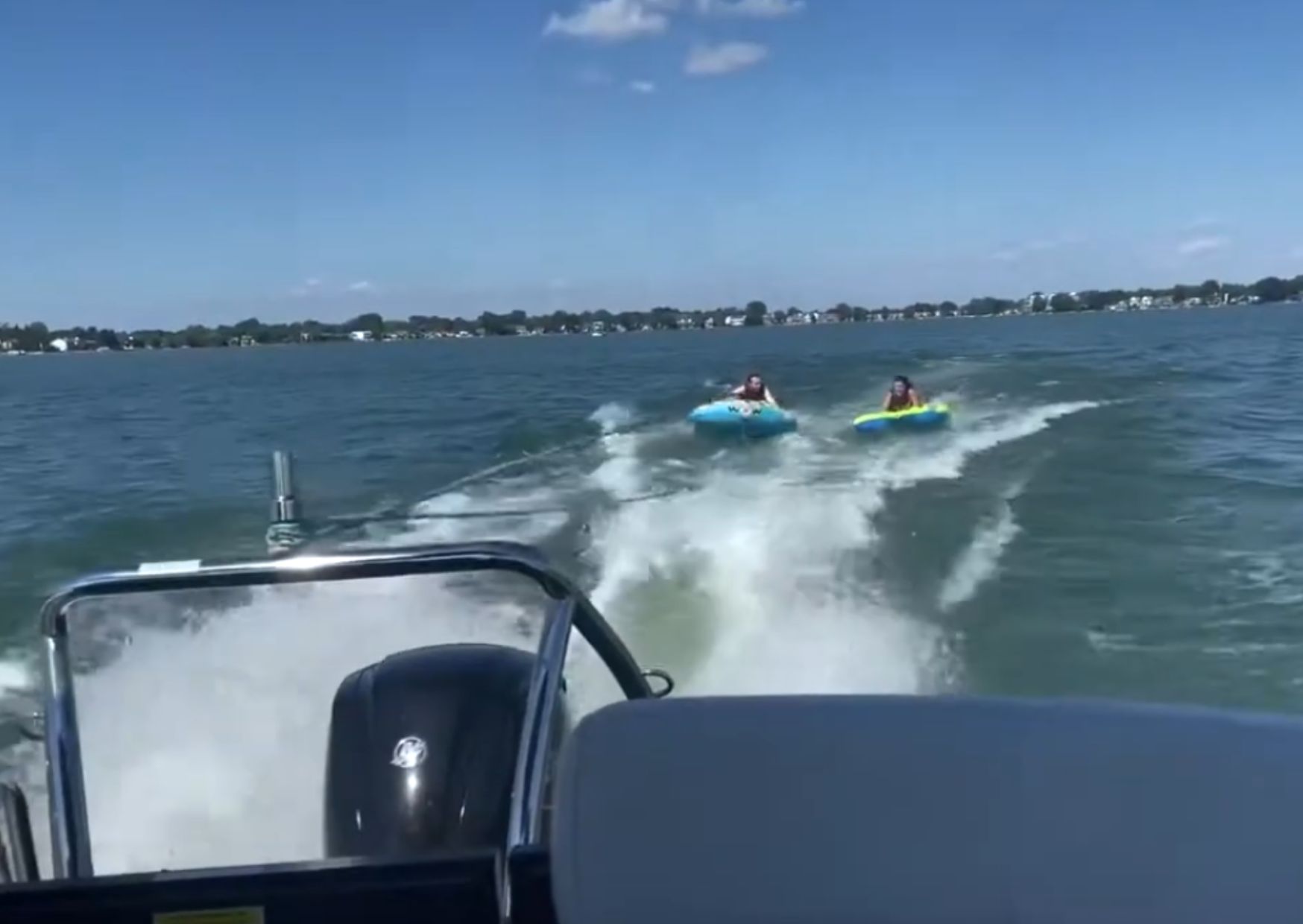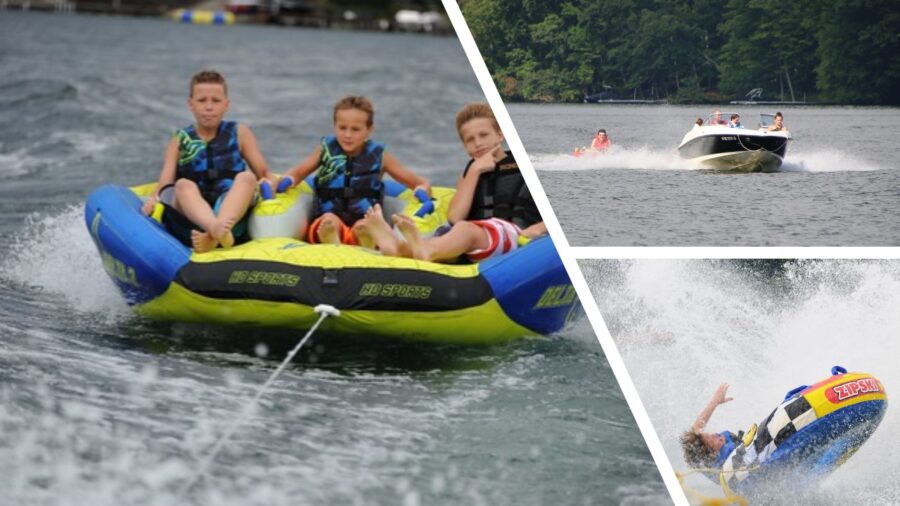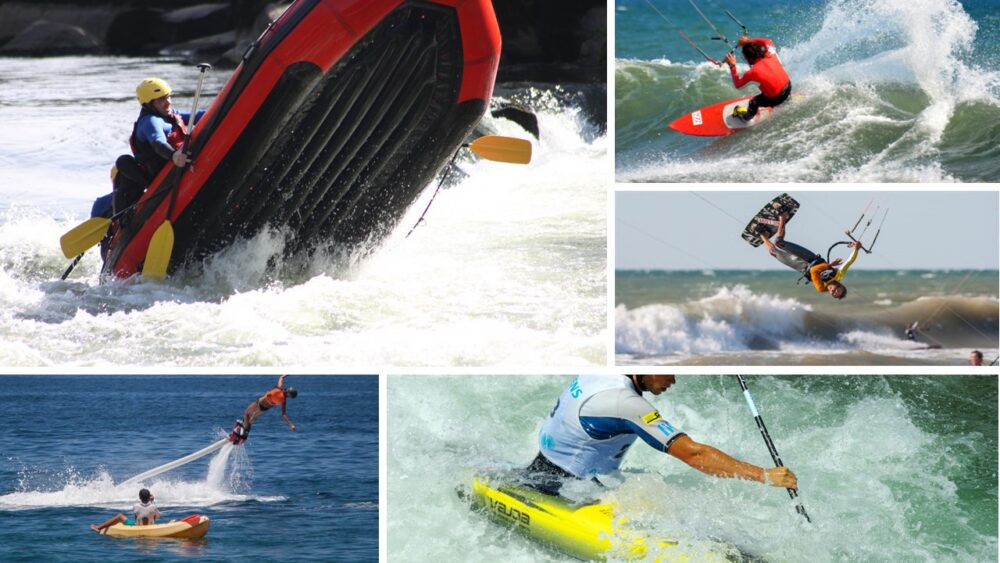Unveiling Dangers Of Tubing Behind A Boat – Stay Safe And Thrive On The Water
Dangers of tubing behind a boat? Are you an adventure enthusiast who loves the thrill of tubing behind a boat? While tubing can be an exhilarating water activity, it’s crucial to understand the potential risks involved.
Did you know that falls and impact injuries are among the most common dangers associated with tubing behind a boat? According to water safety reports, riders can experience bruises, sprains, fractures, or even head trauma upon landing in the water.
Before you hit the water and surrender to the excitement, let’s shed light on some eye-opening facts that will arm you with the knowledge needed to tackle the potential dangers of tubing behind a boat that await.
Dangers Of Tubing Behind A Boat
Just like snow tubing, tubing behind a boat can be an exciting and enjoyable water activity, but it is important to be aware of the potential dangers involved.
Understanding these risks and taking appropriate safety measures can help ensure a safe and enjoyable experience. Here are some common dangers of tubing behind a boat:
1. Falls and Impact Injuries
One of the primary dangers of tubing behind a boat is falling off the tube during high-speed maneuvers or sudden turns. The impact with the water can cause injuries, including bruises, sprains, cuts and more severe injuries like fractures or head trauma.
Riders should be prepared for the possibility of falling and learn how to minimize the risk of injury by maintaining a secure grip on the handles and keeping their body position balanced.
2. Collisions
Collisions with other boats, objects in the water, or even other riders are among the dangers of tubing behind a boat.
It is crucial to maintain a safe distance from other boats and objects and to always be aware of your surroundings.
Communication between the rider and the boat operator, through pre-established signals or a spotter, is vital to avoid accidents.
3. Excessive Speed
Going at excessively high speeds increases the risk of accidents and can make it more difficult for riders to maintain control.
Operators should be mindful of the speed they are towing the tube and consider the rider’s skill level and comfort.
Speed should be adjusted based on the water conditions, such as waves or currents, to ensure a safe experience.
4. Submerged Hazards
Underwater hazards, such as rocks, logs, or shallow areas, pose a significant danger to tubers.
Operators should be familiar with the waterway and know where potential hazards might be located. Riders should also keep an eye out for any changes in water depth or signs of submerged objects to avoid collisions or injuries.
5. Water Conditions
The condition of the water can impact the safety of tubing. Rough or choppy waters can increase the likelihood of falls or injuries. It is essential to check weather conditions and water visibility before going tubing and to avoid tubing during storms, strong winds, or restricted visibility.
6. Fatigue and Overexertion
Tubing can be physically demanding, especially during longer rides or when performing tricks.
Riders should know their limits and take breaks when needed to avoid fatigue, which can lead to reduced coordination and increased risk of accidents.
7. Inadequate Safety Measures
Neglecting safety measures, such as not wearing a properly fitting life jacket or using worn-out or inappropriate equipment, increases the risk of injuries.
It is crucial to always use appropriate safety gear, such as life jackets and helmets, and ensure they are in good condition and properly secured.
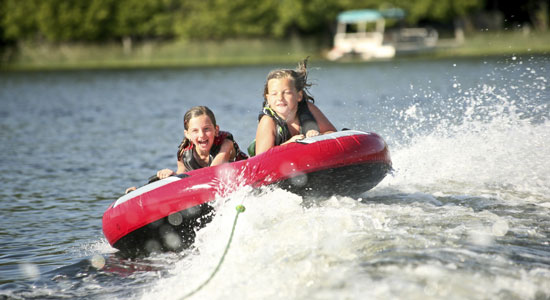
Has Anyone Died From Tubing
Unfortunately, there have been tragic incidents involving tubing that have resulted in fatalities. One such incident occurred on August 6, 2015, involving 16-year-old Emily Fedorko from Greenwich, Connecticut.
While being towed by a motorized boat on Long Island Sound along with a friend, Emily fell off her tube. Tragically, as the boat circled back to their location, Emily was struck by the propeller of the boat’s outboard motor, resulting in her untimely death.
This heartbreaking event serves as a stark reminder of the potential dangers associated with tubing and the importance of adhering to safety precautions to prevent such accidents.
How To Make Tubing Behind A Boat Safe – Safety Equipment For Tubing
When it comes to tubing behind a boat, having the right safety equipment is crucial to ensure the well-being of riders. Here are some essential safety gear items that should be considered to avoid the dangers of tubing behind a boat:
1. Life Jackets: Life jackets, also known as personal flotation devices (PFDs), are vital pieces of safety equipment for tubers of all ages and skill levels.
They provide buoyancy and help keep riders afloat in case of falls or accidents. It is essential to wear a properly fitting, U.S. Coast Guard-approved life jacket that is appropriate for the rider’s weight and size.
2. Helmets: While not as commonly used as life jackets, helmets provide an additional layer of protection for the head. They are particularly recommended for riders engaging in more advanced tubing maneuvers or those attempting tricks.
A well-fitted helmet designed for water sports can help prevent head injuries in case of falls or collisions.
3. Tow Ropes: The tow rope is the link between the boat and the tube. It is essential to use a strong and durable tow rope specifically designed for tubing. Look for ropes made of high-quality materials with sufficient strength to withstand the forces exerted during towing.
Additionally, make sure the tow rope is of an appropriate length to maintain a safe distance between the boat and the tube.
Proper Fitting and Usage
Equally important as having the right safety equipment is ensuring its proper fitting and usage. Here’s why it matters:
1. Life Jacket Fit: A life jacket should fit snugly to provide maximum effectiveness. Ensure that the life jacket is adjusted properly, with all straps secured and fastened. It should be snug enough to prevent the jacket from riding up or slipping off when in the water.
2. Helmet Fit: A helmet should fit comfortably and securely on the rider’s head. It should not be too tight or too loose, as an ill-fitting helmet may not provide adequate protection. Make sure the helmet covers the forehead, temples, and back of the head for optimal coverage.
Recommendations for Different Age Groups and Skill Levels
1. Children: For young children, it is crucial to use appropriately sized life jackets designed for their age and weight. Look for life jackets with extra safety features, such as crotch straps or grab handles, to ensure a secure fit and easy retrieval in case of emergencies.
2. Novice or Inexperienced Riders: Beginners or individuals with limited tubing experience should prioritize safety by using life jackets and considering the use of helmets. Starting with slower speeds and gentler rides can help build confidence and allow them to develop their skills gradually.
3. Advanced Riders: More experienced riders who engage in higher speeds, perform tricks, or participate in competitive tubing may benefit from using helmets as an extra layer of protection. They should also ensure their life jackets are suitable for their size and provide freedom of movement.
Remember that safety equipment is only effective when used correctly. Educate riders on the importance of wearing their life jackets and helmets at all times during tubing activities and provide clear instructions on how to properly secure and utilize the tow ropes.
By prioritizing safety and choosing the right equipment for different age groups and skill levels, you can enhance the overall safety of tubing experiences.
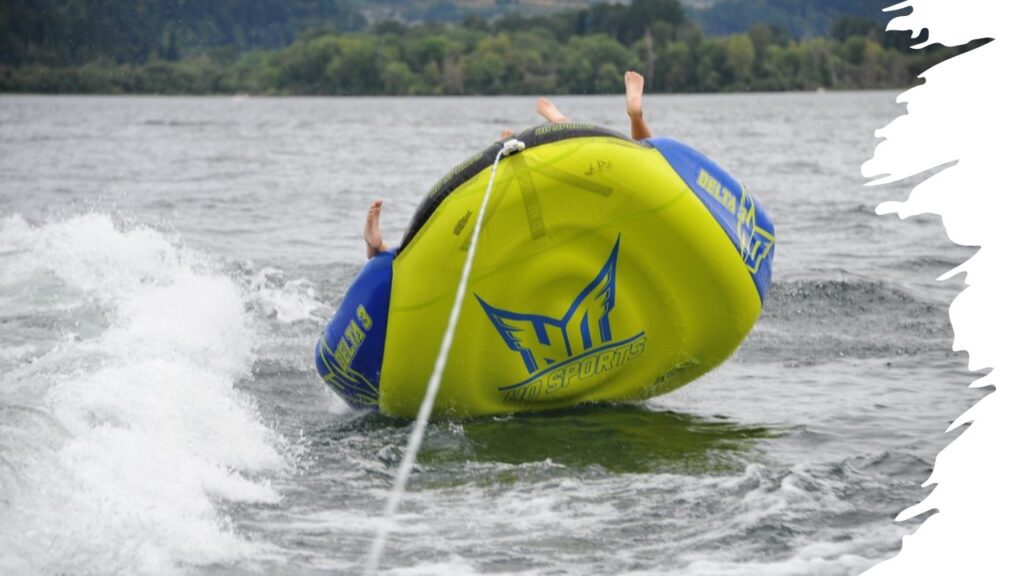
Boat and Equipment Considerations For Safe Tubing (Dangers Of Tubing Behind A Boat)
When engaging in tubing behind a boat, it is crucial to consider both the boat itself and the associated equipment to ensure a safe and enjoyable experience. Here are some important factors to keep in mind:
1. Appropriate Boat Selection
Using an appropriate boat for tubing is essential for safety and performance. Here’s why:
– Sufficient Power: The boat should have enough power to tow tubers comfortably. It should be able to reach and maintain appropriate speeds for tubing while accommodating the weight of both riders and equipment.
– Weight Capacity: The boat should have a weight capacity that can safely handle the combined weight of the riders, towing equipment, and any additional passengers or gear on board.
– Tow Points: The boat should have dedicated tow points designed specifically for tubing. These points should be sturdy, properly positioned, and capable of securely attaching the tow rope.
2. Regular Boat Maintenance and Inspection
Proper boat maintenance and inspection are essential for safe tubing experiences. Consider the following:
– Regular Maintenance: Keep the boat in good working condition by following manufacturer-recommended maintenance schedules. This includes engine checks, propeller inspections, and ensuring all systems are in proper working order.
– Trailer Safety: If using a boat trailer, ensure it is well-maintained, with functioning lights, secure tie-downs, and properly inflated tires.
– Safety Equipment: Check that the boat is equipped with necessary safety gear, such as life jackets, fire extinguishers, and distress signals, and ensure they are in good condition and easily accessible.
3. Selecting the Right Tow Rope and Tube
Choosing the appropriate tow rope and tube is crucial to match the rider’s age, size, and skill level. Here’s what to consider:
– Tow Rope: Select a tow rope specifically designed for tubing. Look for ropes with appropriate length and strength ratings. Consider stretchable ropes that provide a smoother ride and reduce sudden jerks.
– Tube Selection: Choose a tube that suits the rider’s age, size, and skill level. Tubes come in various sizes, designs, and seating capacities. Ensure the tube provides a comfortable and secure seating arrangement, with handles for riders to hold onto during the ride.
– Weight and Capacity: Be mindful of the weight and capacity limits specified by the tube manufacturer. Exceeding these limits can compromise safety and performance.
Remember to provide clear instructions to riders about the proper use and limitations of the equipment. Encourage them to follow recommended guidelines and avoid exceeding weight or capacity limits to minimize the risk of accidents or equipment failures.
Selecting an appropriate boat, conducting regular maintenance and inspections, and matching the tow rope and tube to the rider’s specifications can enhance safety and optimize the tubing experience.
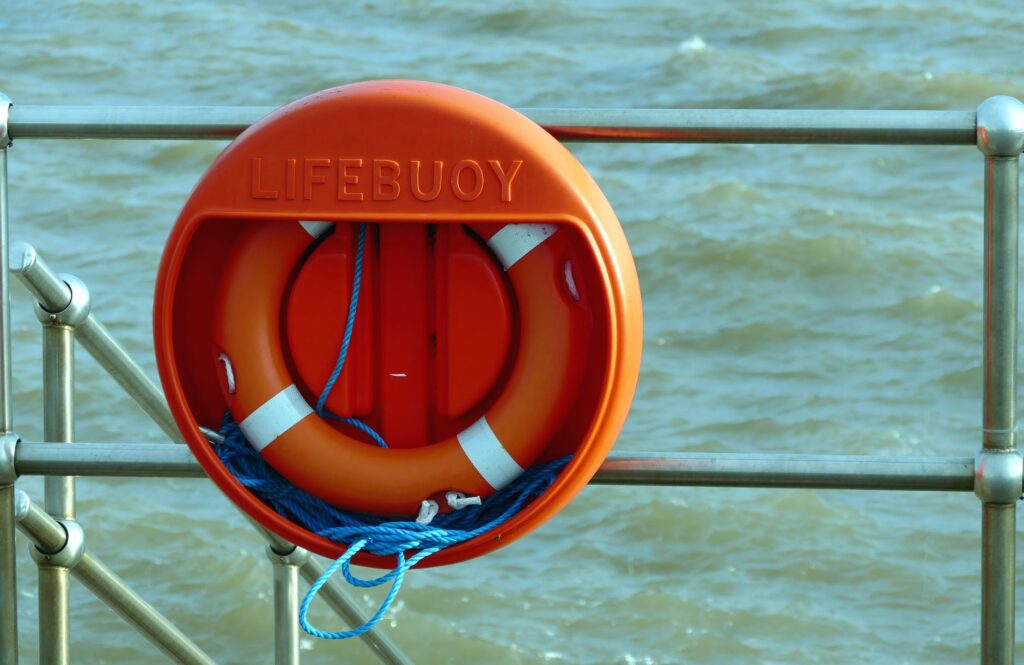
How To Prepare For A Safe Tubing Experience And Avoid Dangers Of Tubing Behind A Boat
To ensure a safe and enjoyable tubing adventure, there are important considerations to keep in mind before hitting the water. Here’s what you need to know:
1. Checking Weather Conditions and Water Visibility
Before tubing, it is essential to assess weather conditions and water visibility to ensure a safe experience:
Weather Conditions
Check the weather forecast for the day and pay attention to any warnings or advisories. Avoid tubing during storms, high winds, or severe weather conditions that can create hazardous boating conditions.
Water Visibility
Assess the water visibility, especially in natural bodies of water. Poor visibility caused by factors such as heavy rainfall or murky conditions can make it difficult to see potential hazards in the water, increasing the risk of accidents. If visibility is compromised, it is advisable to postpone tubing.
2. Securing the Tow Rope and Attaching the Tube
Properly securing the tow rope and attaching the tube to the boat is crucial to maintain safety and stability during the tubing session:
Tow Rope Attachment
Securely attach the tow rope to the boat’s tow point. Ensure it is properly fastened using the appropriate knot or attachment method recommended by the boat and tow rope manufacturer. Double-check for any twists or tangles in the rope before starting the ride.
Tube Attachment
Attach the tube to the tow rope using the provided attachment points or harnesses on the tube itself. Follow the manufacturer’s instructions for securing the tube to the tow rope, ensuring a reliable connection. Ensure the tube is positioned properly and balanced for a stable ride.
3. Communication Signals between Rider and Boat Operator
Clear communication between the rider and the boat operator is essential to maintain safety and coordination during tubing:
Pre-established Signals
Before starting the ride, establish a set of signals that the rider and boat operator can use to communicate. These signals can include hand gestures or predefined movements that indicate the rider’s comfort level, readiness, or requests to adjust speed or direction.
Spotter/Observer
It is recommended to have a dedicated spotter on the boat who can maintain visual contact with the rider at all times. The spotter’s role is to communicate with the boat operator and keep an eye on the rider’s safety, offering assistance or alerting the operator of any concerns.
Encourage open communication and emphasize the importance of adhering to the signals and instructions provided by the boat operator and spotter throughout the tubing experience. This ensures a coordinated and safe ride for everyone involved.
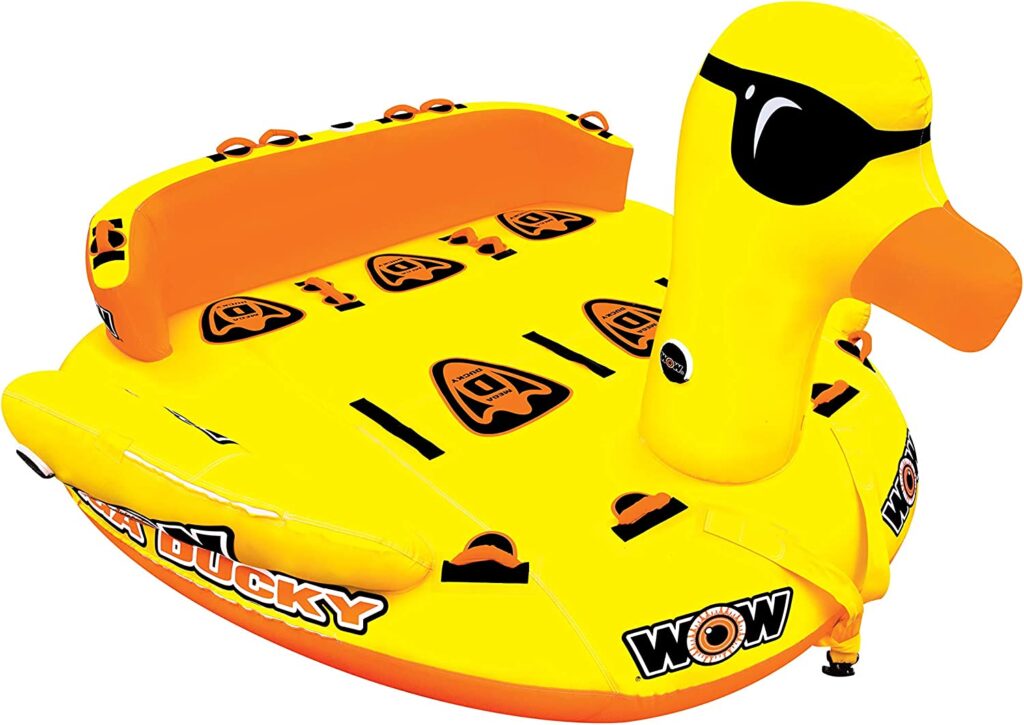
Understanding And Mitigating Risks In Tubing
Tubing, like any water activity, comes with inherent risks. It’s important to be aware of these risks and take appropriate measures to mitigate them. Here are common risks associated with tubing and safety strategies to minimize them:
1. Falls, Collisions, and Impact Injuries
Falling off the tube is a common risk in tubing. Riders can reduce this risk by maintaining a secure grip on the handles, keeping their body position balanced, and being prepared for sudden turns or maneuvers.
Collisions with other boats, objects in the water, or fellow riders are potential dangers. Maintaining situational awareness, following boating rules and regulations, and keeping a safe distance from other watercraft can help avoid collisions.
2. Identifying Potential Hazards in the Water
Submerged objects, shallow areas, or strong currents can pose hazards while tubing. It is important to scan the water ahead and around you for any signs of potential dangers.
Look for changes in water color or texture that may indicate shallow areas. Be cautious of areas with debris, rocks, or underwater obstacles. Pay attention to currents and avoid areas with strong or unpredictable water flow.
3. Safety Strategies to Minimize Risks
Maintain a Safe Distance: Keep a safe distance from other boats, swimmers, or objects in the water to minimize the risk of collisions. Be aware of your surroundings and adjust your direction or speed accordingly.
Establish Speed Limits
Determine suitable speed limits for tubing based on factors such as the rider’s skill level, water conditions, and the presence of other boats or swimmers. Follow local speed regulations and be mindful of creating excessive wakes or waves that may disturb other water users.
Use a Spotter
Having a dedicated spotter on the boat can enhance safety. The spotter can maintain visual contact with the rider, provide alerts about potential hazards, and communicate with the boat operator.
Practice Defensive Tubing
Encourage riders to be proactive in their own safety by staying alert, being aware of their surroundings, and avoiding reckless behavior. Encourage responsible tubing practices, such as avoiding horseplay, respecting others’ space on the water, and obeying boating rules and regulations.
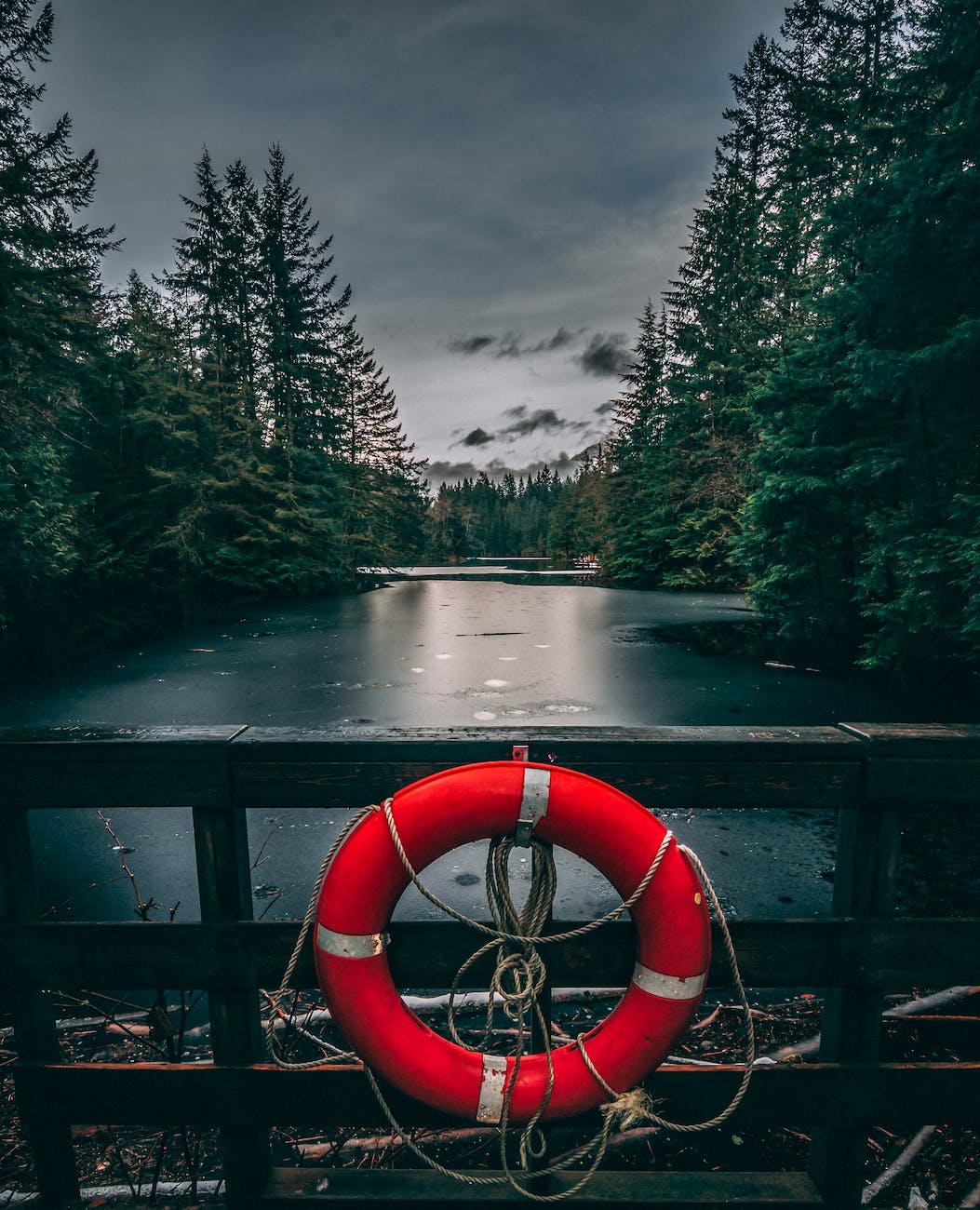
Safety Rules And Best Practices For Tubing (Dangers Of Tubing Behind A Boat)
To ensure a safe and enjoyable tubing experience, it is crucial to follow essential safety rules and adhere to best practices. Here are some guidelines to keep in mind to avoid the dangers of tubing behind a boat:
1. No Alcohol or Drug Use
Tubing while under the influence of alcohol or drugs significantly impairs judgment, coordination, and reaction time, increasing the risk of accidents and injuries. It is essential to abstain from alcohol or drugs before and during tubing activities.
2. Have a Spotter on the Boat
A spotter on the boat plays a critical role in maintaining visual contact with the rider at all times. The spotter can alert the boat operator to any potential hazards, provide assistance to the rider, and ensure a swift response in case of emergencies.
3. Proper Tubing Behavior
Avoid Sudden Movements
Sudden and erratic movements on the tube can lead to loss of balance or falls. Encourage riders to make smooth and controlled motions, avoiding abrupt changes in direction or excessive bouncing.
Stay in Control
Riders should strive to maintain control of the tube throughout the ride. They should be aware of their limits, ride within their comfort zone, and avoid attempting maneuvers or speeds that exceed their skill level.
Respect Others’ Space
Tubing often takes place in shared waterways, so it’s important to respect the space and rights of other boaters, swimmers, and watercraft. Keep a safe distance from others, maintain a responsible speed, and avoid interfering with other water activities.
4. Follow Boating Regulations
Observe and comply with all boating regulations, including speed limits, no-wake zones, and navigation rules. Be aware of any specific rules or restrictions in the area where you are tubing and follow them accordingly.
5. Use Hand Signals and Communication
Establish clear hand signals or predefined gestures between the rider and the spotter/boat operator. These signals can indicate readiness, discomfort, or requests to adjust speed or direction. Consistent communication helps ensure a coordinated and safe tubing experience.
6. Wear Appropriate Safety Gear
Always wear a properly fitted and U.S. Coast Guard-approved life jacket or personal flotation device (PFD). Consider using a helmet for added head protection, especially for advanced riders or those attempting tricks.

Emergency Preparedness for Tubing To Avoid The Dangers Of Tubing Behind A Boat
While tubing is a fun and exciting water activity, it’s essential to be prepared for potential emergencies that may arise. Here’s what you need to know:
1. Common Tubing-Related Emergencies
Rider Fatigue
If a rider shows signs of fatigue or exhaustion, it’s important to end the tubing session and allow them to rest. Continuing to tube when fatigued can increase the risk of falls or accidents. Encourage riders to take breaks, stay hydrated, and listen to their bodies.
Falls and Accidents
In the event of a fall or accident, follow these steps:
– Boat Operator’s Response: Immediately slow down the boat and steer away from the fallen rider, creating a safe distance to avoid further injury.
– Spotter’s Role: The spotter should maintain visual contact with the rider and communicate with the boat operator. They can guide the boat toward the fallen rider and provide assistance if needed.
– Rider Rescue: If the rider is unable to swim to the boat or is injured, use the spotter or another responsible individual to assist in bringing them safely aboard.
2. Responding to Injuries
Basic First Aid
It’s essential to have a basic understanding of first aid techniques to provide initial care for injuries. Some key steps include:
– Assessing the Situation: Evaluate the nature and severity of the injury. If the injury appears serious, immobilize the rider and seek professional medical help immediately.
– Controlling Bleeding: Apply direct pressure to any bleeding wounds using a clean cloth or bandage to help stop the bleeding.
– Treating Minor Injuries: Clean minor wounds with mild soap and water, apply antiseptic ointment and cover them with a sterile dressing or bandage.
Seeking Medical Help
In the case of more severe injuries or if you are unsure about the extent of an injury, it’s crucial to seek professional medical assistance promptly. Contact emergency medical services or transport the injured individual to the nearest medical facility.
3. Emergency Contact Information and Local Regulations
Emergency Contact Information
Always have emergency contact information readily available, including local emergency services and the nearest medical facilities. Share this information with all participants and ensure it is easily accessible on the boat.
Local Boating Regulations
Familiarize yourself with local boating regulations, including any specific rules or requirements in the area where you will be tubing. Adhering to these regulations helps ensure your safety and avoids any potential legal issues.

How To Get Help If You Are Injured While Tubing
If you are injured while tubing, it is crucial to seek help promptly to ensure your well-being. Here’s what you should do to get assistance when injured during tubing:
1. Assess Your Injury
Take a moment to assess the nature and severity of your injury. Determine if it requires immediate medical attention or can be managed with basic first aid techniques.
2. Signal for Help
If you are unable to reach the boat or shore on your own or if your injury prevents you from moving, signal for help. Wave your arms or make noise to attract the attention of people nearby, including the boat operator, other riders, or individuals on the shore.
3. Boat Operator’s Assistance
Communicate with the boat operator or the spotter, if available, about your injury and the need for immediate help. They can initiate the necessary actions to help or call for emergency medical services.
4. On-Board First Aid Kit
If the boat has an on-board first aid kit, it may contain supplies that can help manage minor injuries or provide temporary relief. Ask for assistance in accessing the first aid kit, if available.
5. Seek Professional Medical Help
For severe injuries or if you are uncertain about the extent of your injury, it is important to seek professional medical help. Consider the following options:
Contact Emergency Services: In cases of severe injuries, or if you believe it is an emergency, call the local emergency services hotline (e.g., 911 in the United States) for immediate assistance. Provide them with accurate information about your location and the nature of the injury.
Transport to Medical Facility: If the injury requires medical attention but is not an immediate emergency, coordinate with the boat operator or others on board to transport you to the nearest medical facility or hospital for assessment and treatment.
6. Emergency Contact Information
Ensure that you or someone in your group has access to emergency contact information, including local emergency services and medical facilities.
It is important to have this information readily available, either on your phone or in a waterproof container on the boat, for quick reference in case of emergencies.
RELATED: Do Water Shoes Protect Against Stingrays
Tips For Choosing a Safe Location to Tube (Dangers Of Tubing Behind A Boat)
Selecting the right location for tubing is crucial to ensure a safe and enjoyable experience. Here are some tips to help you choose a safe tubing location:
1. Avoid Areas with Hazards:
– Rocks and Submerged Objects: Look for locations that have clear and open water, free from rocks, boulders, or other submerged objects that could pose a risk of collision or injury.
– Debris and Obstructions: Avoid areas with significant debris, such as fallen branches, logs, or floating debris. These obstructions can cause accidents or entanglement with the tow rope or tube.
– Shallow Areas and Sandbars: Stay away from shallow areas or sandbars, as they can cause the tube to hit the bottom, potentially resulting in injuries to riders.
2. Choose Designated Water Recreation Areas
– Opt for locations that are designated for water recreation activities, as these areas are typically monitored and regulated to ensure safety.
– Look for public beaches, lakes, or rivers with designated areas for water sports and tubing. These areas often have clear boundaries, signage, and dedicated spaces for boating and tubing activities.
3. Seek Local Knowledge and Recommendations
– Consult with locals or experienced tubers in the area for recommendations on safe tubing locations. They can provide valuable insights on ideal spots, water conditions, and any potential hazards to be aware of.
– Reach out to local boating or water sports associations, recreational departments, or visitor information centers for guidance on safe tubing locations in the area.
4. Consider Water Conditions and Currents
– Assess the water conditions, including currents and tides, before choosing a tubing location. Avoid areas with strong or unpredictable currents that can make tubing challenging or unsafe.
– Be mindful of weather conditions, as changes in wind speed, storms, or rapid water level fluctuations can impact the safety and enjoyment of tubing.
5. Follow Local Regulations and Restrictions
Familiarize yourself with any specific regulations or restrictions in the area regarding tubing activities. These may include speed limits, no-wake zones, or specific operating hours. Adhering to these rules helps ensure the safety of all water users.
Is River Tubing Dangerous?
Yes. River tubing can be dangerous due to various factors such as strong currents, submerged hazards, changing water levels, and lack of control. These risks can lead to accidents, injuries, or even fatalities.
Therefore, it is important to approach river tubing with caution and take appropriate safety measures.
Adhering to safety guidelines, wearing proper safety equipment like life jackets, being aware of water conditions, and selecting rivers that match your experience and skill level can help mitigate some of the dangers associated with river tubing.
However, it’s essential to understand that despite precautions, there is always some level of inherent risk involved in river tubing activities. Therefore, individuals should assess their own capabilities, consider the current conditions, and make informed decisions to ensure their safety.
Is Snow Tubing Dangerous?
Snow tubing can pose inherent risks, but when proper safety measures are followed, it can be a relatively safe activity.
Snow tubing can be considered a relatively safe winter activity if conducted in designated tubing areas and with adherence to safety guidelines.
The risks associated with snow tubing primarily arise from the speed and momentum gained while descending the slopes. Factors such as collisions, falls, and impacts with objects or other tubers can lead to injuries.
However, many snow tubing facilities take precautions to minimize these risks. They often provide groomed lanes, controlled speeds, and safety barriers to ensure a safer tubing experience.
Additionally, participants are typically required to follow specific rules and guidelines, including age restrictions, weight limits, and instructions on proper positioning and conduct while tubing.
READ ALSO: Do Water Shoes Protect Against Sea Urchins
Tubing At 50 Mph: How Fast Should You Go When Tubing
When it comes to determining the appropriate speed for tubing, there isn’t a one-size-fits-all answer as it depends on various factors, including the skill level of the tubers, water or snow conditions, and the specific regulations or guidelines of the area or facility where tubing is taking place.
In general, it is recommended to start tubing at lower speeds, especially for beginners or those who are less experienced. This allows riders to become comfortable with the activity and maintain control of the tube.
As riders gain confidence and proficiency, they may gradually increase the speed within reasonable limits.
It’s crucial to prioritize safety and adhere to any speed limits or recommendations provided by the facility or local authorities.
Additionally, factors such as weather conditions, water currents (in the case of water tubing), and the presence of obstacles or other users should be taken into consideration when determining the appropriate speed.
Ultimately, it is essential to use good judgment, be aware of personal limitations, and always prioritize safety over achieving high speeds. Following the guidance and instructions of experienced operators, supervisors, or facility staff can help ensure a safe and enjoyable tubing experience.
RELATED: 15 Best Aquasocks: Elevating Your Water Adventures With Style And Confidence!
Is Tubing In The Ocean Safe
Tubing in the ocean can present additional risks and challenges compared to tubing in controlled environments like lakes or designated tubing areas.
Tubing in the ocean can be potentially hazardous and should be approached with caution. The ocean is subject to strong currents, waves, and unpredictable conditions that can increase the risk of accidents and injuries.
Factors such as undertows, rip currents, large waves, and offshore winds can make tubing in the ocean more challenging and potentially dangerous.
Additionally, the presence of other watercraft, swimmers, and marine wildlife adds another layer of complexity and risk to ocean tubing. The vastness and sometimes unpredictable nature of the ocean require a higher level of skill, experience, and awareness compared to other water environments.
Can You Get Hurt Snow Tubing
Yes, it is possible to get hurt while snow tubing. Snow tubing, like any recreational activity, carries inherent risks, and accidents can occur. The specific risks involved in snow tubing include:
1. Falls and Collisions: Snow tubing involves descending slopes at varying speeds. Falls from the tube or collisions with other tubers, objects, or obstacles can lead to injuries such as bruises, sprains, or fractures.
2. Impact Injuries: The force of impact during a fall or collision can cause injuries to different parts of the body, including the head, neck, back, or extremities. These injuries can range from minor to severe, depending on the circumstances.
3. Slipping or Tripping: Snowy surfaces can be slippery, increasing the likelihood of slips or trips when getting on or off the tube. This can result in injuries such as sprains, strains, or cuts.
4. Overexertion: Engaging in repetitive tubing runs or attempting maneuvers beyond one’s physical abilities can lead to muscle strains, fatigue, or overexertion injuries.
RELATED: What Is The Best Sunscreen For Beach – Top 10 Sunscreen Recommended By Experts
Dangers Of Tubing Behind A Boat FAQs
What Is Tubing Behind A Boat?
Tubing behind a boat involves riding on an inflatable tube while being towed by a motorized boat. It’s a recreational water activity enjoyed by many.
Is Tubing Behind A Boat Safe?
Tubing can be safe when proper safety measures are followed. However, there are inherent risks, and accidents can happen if precautions are not taken.
What Are The Primary Dangers Of Tubing Behind A Boat?
The primary dangers include collisions with obstacles, falls off the tube, and impact injuries caused by sudden stops or sharp turns.
Do I Need A Life Jacket While Tubing?
Yes, wearing a Coast Guard-approved life jacket is essential when tubing behind a boat. It provides buoyancy and can save your life in case of a fall.
What Should I Consider When Choosing A Tubing Location?
Factors to consider include water depth, proximity to other boats, and the absence of obstacles like rocks or submerged logs.
Can Tubing Be Dangerous For Children?
Yes, tubing can be dangerous for children if not supervised properly. Children should wear life jackets and be closely monitored by adults.
What Speed Should The Boat Travel While Towing A Tube?
The recommended speed for tubing varies but is generally around 20-25 mph. It’s crucial to follow the manufacturer’s guidelines for your specific tube.
How Can I Communicate With The Boat Driver While Tubing?
Hand signals are typically used to communicate with the boat driver. Common signals include thumbs up (faster), thumbs down (slower), and tapping the head (stop).
What Do I Do If I Fall Off The Tube While Tubing?
If you fall off the tube, remain calm, and raise your hand to signal the boat to stop. Wait for the boat to circle back and pick you up.
Are There Age Restrictions For Tubing Behind A Boat?
Age restrictions may vary by location and local regulations. It’s essential to check the legal requirements in your area before allowing children to tube.
Can Weather Conditions Affect Tubing Safety?
Yes, adverse weather conditions like strong winds, storms, or rough waters can make tubing unsafe. It’s advisable to tube in calm and clear weather.
Is It Necessary To Receive Training Before Tubing?
While formal training is not always required, it’s recommended, especially for boat operators. Training can help ensure safe practices and proper handling of equipment.
What Should I Do To Maintain My Tubing Equipment?
Regularly inspect your tubing equipment for wear and tear. Check for leaks, secure connections, and ensure the tow rope is in good condition.
Are There Any Legal Or Liability Considerations For Tubing?
Legal and liability considerations may vary by location and jurisdiction. It’s wise to be aware of any local regulations and consider liability insurance.
What Are Some Tips For Having A Fun And Safe Tubing Experience?
Enjoy tubing responsibly by following safety guidelines, wearing proper gear, and being aware of your surroundings. Having fun and staying safe go hand in hand.
The Bottom Line On Dangers Of Tubing Behind A Boat
While tubing behind a boat can be an exhilarating experience, it’s essential to be aware of the potential dangers involved. By understanding and addressing the Dangers of Tubing Behind a Boat, such as falls, collisions, and impact injuries, we can prioritize safety and minimize risks.
Remember to follow safety guidelines, use appropriate safety equipment, choose suitable locations, and communicate effectively with the boat operator and spotter. With proper precautions, you can enjoy the thrill of tubing while ensuring a safe and unforgettable adventure on the water.
